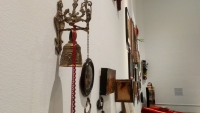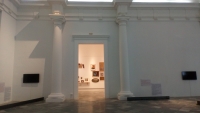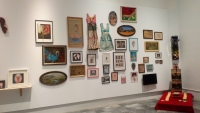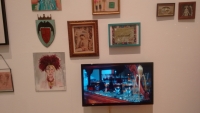De Reüll:1990-2020
House of Bent is an installation carried out in the context of the collective exhibition “De Reüll:1990-2020. Cultivate, share, practice…” curated by Rafael Tormo Cuenca at the CCCC Arts Centre in Valencia which took place from december 2020 to february 2021. The installation carried out by La Erreria (House of Bent) uses a transfeminist and queer methodology to blur the boundaries between art, crafts and “handicrafts” in order to question the values of the art institutions and the art market. Based on the collection of our house-museum in Xàtiva, it reflected an alternative way to construct a collection, based on affectivity, story-telling and queer/transfeminist activism.
The installation included assemblages from our series R.I.P. (Reproducción Intervenida Procedente- del Rastro de Valencia, which translates roughly as Intervened Reproduction Procured at the fleamarket of Valencia) and U.D.M.A.D. (trans: Uniform of Director of the Museum of Decorative Arts) alongside work by Aldo Alcota, Alice Roth, Almudena López, Amaury Grisel, Angela Dalinger, Annie Sprinkle y Beth Stephens, Balfourgisnacht Monster, Cabello/Carceller, Chris Korda, Divine David, J. Palacios, Joan Isobel Bell, jole, Jose Ruiz Segura, Macarena De La Cruz, Marquéz de Gea, Mery Sut, O.R.G.I.A., Prefix-poly, Rampova, Rapha Hu, Samantha Sweeting, Simon Murphy and Toni Cordero.
Apart from the House of Bent installation the exhibition included a recent interview with La Ciskar my drag alter ego (based on Consuelo Ciscar, the ex director of the nearby IVAM museum) in which I carried out a critique of the role of the institution and of the curator.
If art is a vehicle of social transformation, a way of experimenting politically, aesthetically with life we must develop strategies in our dealings with the system. In this exhibition Tormo attempted to expand the horizons of the institution in a curatorial project which inverted the usual hierarchies upheld by the institution, putting outsider art, art made by housewives, queers, drag queens and geeks alongside the work of radically political artists like Santiago Serra and Josep Renau who form part of the hallowed modern/contemporary art cannon.
The exhibition was audacious, ambitious and decidedly queer in the way in which it overturned hierarchies, and dissolved boundaries. Loosely based on the work of the artists collective De Reüll, whose main objective is the promotion of the visual arts, the exhibition presented the work of the group showing documentation of the exhibitions, publications and conferences they have organised alongside the work of other collectives and artists which situated the group chronologically within its historical and sociopolitical context and analysed the failed project of the Spanish transition from dictatorship to democracy.
This unusual approach created a frame of reference for their work placing it in a wider context which extended from the past -and the masterly anti fascist collages of Josep Renau (1907-1982)- to the future with the highly popular frieze based on the memes of the collective Kalebarraka.
Tormo´s project was in line with his practice of "pensamiento crítico" (critical thinking), a way of inhabiting the paradox, of assuming our position as subjects living in a system we despise but cannot escape, a system that we form part of however much we may try to convince ourselves we are uncontaminated by it. Another way to frame this kind of discourse is through queer theory and there were many other LGTBQ artists in the exhibition including William James with images of a project carried out with De Reüll or Juan Del Gado, a photographer who documented (in slides that are projected) the drag scene that formed around the mythical bar Covarrubias where Champán the "first republican drag queen" performed. Si llegas o es regreso (1995) is a short film by the director Sigfrid Monleón which recalls Fassbinder's Querelle (1982). Based on the poetry of Gil de Biedma the film documents a train journey where the poet spies on three russian sailors from the battleship Potemkin travelling to an unknown destination. It thus connects homoeroticism with communism in a dreamlike series of images where the sailors seem to challenge the camera, seducing it.
In many ways the exhibition was a labour of love for the rebel spirits of Valencia with work by artists and collectives who exemplify Tormo´s radical politics which situate the peripheral at the centre of his discourse. This was an exhibition which refused to be categorised - Was it a retrospective, a group or a themed exhibition? Did it represent De Reüll, contemporary valencian art or critical art practises?
In this exhibition the hierarchies at work in art institutions were constantly being broken. Newspaper articles were displayed in glass cabinets like priceless works of art while the work of an outsider artist like Citizen Manduca was given pride of place over other more well known artists. You didn´t need a registered trademark to be in this exhibition, but that did not mean that there was no criterion in the selection. The criterion here was art which is attitude changing, art made collectively, art which attacks the status quo.
In other words, art which is annoying, punk, queer.
House of Bent es una instalación realizada en el contexto de la exposición colectiva “De Reüll:1990-2020. Cultivar, compartir, practicar. De representacions, pràctiques i contextos” comisariada por Rafael Tormo Cuenca en el Centro del Carmen de Valencia desde diciembre 2020 a febrero 2021. La instalación, realizado con La Erreria (House of Bent) utiliza una metodología transfeminista y queer/cuir para difuminar los limites entre arte, artesanía y manualidades y cuestionar los valores de las instituciones y el mercado del arte. House of Bent es una instalación en torno a la colección de nuestra casa-museo La Erreria de Xàtiva y muestra una forma alternativa de hacer coleccionismo basada en la afectividad, el relato y el activismo cuir/transfeminista.
La instalación incluye varias assemblages y creaciones de las series R.I.P. (Reproducción Intervenida Procedente- del Rastro de Valencia) y U.D.M.A.D. (Uniforme de Director/a de Museo de Artes Decorativos) además de obras de Aldo Alcota, Alice Roth, Almudena López, Amaury Grisel, Angela Dalinger, Annie Sprinkle y Beth Stephens, Balfourgisnacht Monster, Cabello/Carceller, Chris Korda, Divine David, J. Palacios, Joan Isobel Bell, jole, Jose Ruiz Segura, Macarena De La Cruz, Marquéz de Gea, Mery Sut, O.R.G.I.A., Prefix-poly, Rampova, Rapha Hu, Samantha Sweeting, Simon Murphy y Toni Cordero.
Aparte de House of Bent, la exposición incluye una entrevista realizada adrede con mi alter ego drag La Ciskar, un personaje punk basado en Consuelo Ciscar, la ex directora del IVAM (el Instituto Valenciano de Arte Moderno – institución que queda muy cerca del Centro del Carmen), donde realizo una crítica de la institución y del papel de curador.
Si el arte es un vehículo de transformación social, una forma de experimentar política y estéticamente con la vida, tenemos que desarrollar estrategias en nuestros tratos con el sistema. En esta exposición, Tormo intenta ampliar los horizontes de la institución en un proyecto curatorial que invierte las jerarquías habituales de la institución, poniendo el arte putsider, el arte realizado por las amas de casa, queers, drag queens y los geeks junto con el trabajo de artistas radicalmente políticos como Santiago Serra y Josep Renau, que forman parte del cañón de arte moderno / contemporáneo santificado.
La exposición es audaz, ambiciosa y decididamente queer en la manera en que anula las jerarquías y disuelve los límites. Basado en el trabajo de colectivo artístico De Reüll, cuyo objetivo principal es la promoción de las artes visuales, la exposición presenta el trabajo del grupo a través de la documentación de las exposiciones, publicaciones y conferencias que ha organizado junto con el trabajo de otros colectivos y artistas que sitúan el grupo dentro de su contexto histórico y social y analiza el proyecto fallido de la Transición en España desde una dictadura a una democracia. Este enfoque inusual crea un marco de referencia para su trabajo colocándolo en un contexto más amplio que se extiende desde el pasado, y los collages maestros anti fascistas de Josep Renau (1907-1982), hasta el futuro con el friso enormemente popular basado en los memes del colectivo Kalebarraka.
El proyecto de Tormo está en línea con su práctica de pensamiento crítico, una forma de habitar la paradoja, de asumir nuestra posición como sujetos que viven en un sistema, que no podemos escapar, de lo cual formamos parte por mucho que tratamos de convencernos de lo habitamos sin contaminarnos. Otra forma de enmarcar este tipo de discurso es a través de la teoría queer y hay muchxs otrxs artistas de LGTBQ en la exposición, incluyendo William James con imágenes de un proyecto realizado con De Reüll; el fotógrafo Juan Del Gado, que documentó (en diapositivas que están proyectadas) la escena transformista que había en torno al bar mítico Covarrubias donde actuaba Champán la "primera transformista republicana" de Valencia, y un cortometraje del director de cine Sigfrid Monleón (director del "Cónsul de Sodoma" ) con su Si llegas o es retorno (1995) basado en la poesía de Gil de Biezma que recuerda el Querelle (1982) de Fassbinder. La película documenta un viaje en tren donde el poeta espía a tres navegantes rusos del acorazado Potemkin que viajan a un destino desconocido. Así conecta el homoerotismo con el comunismo en una serie de imágenes de ensueño donde los marineros parecen desafiar a la cámara, seduciéndola.
En muchos sentidos, la exposición es un trabajo de amor por los espíritus rebeldes de Valencia con obras de artistas y colectivos que ejemplifican la política radical de Tormo que sitúa la periferia en el centro de su discurso. Se trata de una exposición que niega a ser categorizada - ¿Es una retrospectiva, una muestra colectiva o temática? ¿Representa a De Reüll, el arte valenciano contemporáneo o las prácticas artísticas críticas?
En esta exposición, las jerarquías que operan en las instituciones artísticas se quiebran constantemente. Artículos de periódicos se exhiben, como valiosas obras de arte, en vitrinas; mientras que las obras de un artista eccentrico y practicamente desconocido como Ciutadà Manduca ocupa un lugar de honor por encima de otros artistas más conocidos.
No es necesario tener un certificado compulsado de denominacion de origen para estar seleccionado, pero esto no significa que no hay un criterio: el arte como una manera de transformacion social, revulsiva, colectiva y sobre todo en contra del estatus quo.
Y esto siempre molesta, es punk, es queer.






